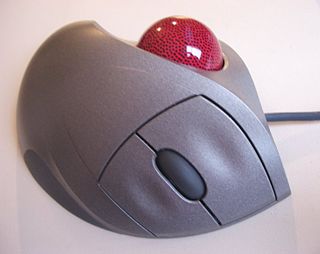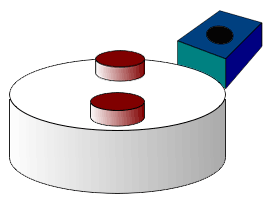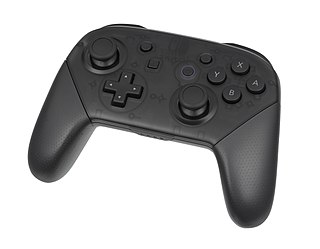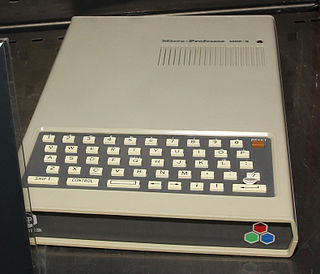Related Research Articles

A joystick, sometimes called a flight stick, is an input device consisting of a stick that pivots on a base and reports its angle or direction to the device it is controlling. A joystick, also known as the control column, is the principal control device in the cockpit of many civilian and military aircraft, either as a centre stick. It has various switches to control the movements of the aircraft controlled by the Pilot and First Officer of the flight.

A trackball is a pointing device consisting of a ball held by a socket containing sensors to detect a rotation of the ball about two axes—like an upside-down ball mouse with an exposed protruding ball. Users roll the ball to position the on-screen pointer, using their thumb, fingers, or the palm of the hand, while using the fingertips to press the buttons.

The MCS-48 microcontroller series, Intel's first microcontroller, was originally released in 1976. Its first members were 8048, 8035 and 8748. The 8048 is argueably the most prominent member of the family. Initially, this family was produced using NMOS technology. In the early 1980s, it became available in CMOS technology. It was manufactured into the 1990s to support older designs that still used it.

The Intel 8085 ("eighty-eighty-five") is an 8-bit microprocessor produced by Intel and introduced in March 1976. It is software-binary compatible with the more-famous Intel 8080 with only two minor instructions added to support its added interrupt and serial input/output features. However, it requires less support circuitry, allowing simpler and less expensive microcomputer systems to be built. The "5" in the part number highlighted the fact that the 8085 uses a single +5-volt (V) power supply by using depletion-mode transistors, rather than requiring the +5 V, −5 V and +12 V supplies needed by the 8080. This capability matched that of the competing Z80, a popular 8080-derived CPU introduced the year before. These processors could be used in computers running the CP/M operating system.

A game controller, gaming controller, or simply controller, is an input device or input/output device used with video games or entertainment systems to provide input to a video game. Input devices that have been classified as game controllers include keyboards, mouses, gamepads, and joysticks, as well as special purpose devices, such as steering wheels for driving games and light guns for shooting games. Controllers designs have evolved to include directional pads, multiple buttons, analog sticks, joysticks, motion detection, touch screens and a plethora of other features.

A Hall effect sensor is a type of sensor which detects the presence and magnitude of a magnetic field using the Hall effect. The output voltage of a Hall sensor is directly proportional to the strength of the field. It is named for the American physicist Edwin Hall.

Microsoft SideWinder was the general name given to the family of digital game controllers developed by Microsoft for PCs. The line was first launched in 1995. Although intended only for use with Microsoft Windows, Microsoft SideWinder game controllers can also be used with macOS, Mac OS 9 with third-party software, and Linux.

A gamepad is a type of video game controller held in two hands, where the fingers are used to provide input. They are typically the main input device for video game consoles.
The Mitsumi Electric Co., Ltd. was a Japanese manufacturer of consumer electronic components, founded in 1954.

Microprofessor II, introduced in 1982, was Multitech's second branded computer product and also one of the earliest Apple II clones. It does not look like most other computers. The case of the MPF II was a slab with a small chiclet keyboard on its lower part.
Saitek is a designer and manufacturer of consumer electronics founded in 1979 by Swiss technologist Eric Winkler. They are best known for their PC gaming controllers, mice, keyboards, and their numerous analogue flight controllers such as joysticks, throttles, and rudder pedals.
A rugged computer or ruggedized computer is a computer specifically designed to operate reliably in harsh usage environments and conditions, such as strong vibrations, extreme temperatures and wet or dusty conditions. They are designed from inception for the type of rough use typified by these conditions, not just in the external housing but in the internal components and cooling arrangements as well.

3Dconnexion is a German manufacturer of human interface devices for manipulating and navigating computer-generated 3D imagery. These devices are often referred to as 3D motion controllers, 3D navigation devices, 6DOF devices or a 3D mouse.

Fischer Connectors is a Swiss multinational company that designs, manufactures and distributes electrical connectors and optical fiber connectors, cable assemblies and electronic and connectivity systems. Founded in 1954, the company has its main manufacturing facility and R&D Center in Saint-Prex, Switzerland, and eight subsidiaries employing 550 people worldwide, with cable assembly facilities in Europe, North America and Asia Pacific. Fischer Connectors is part of Conextivity Group.

In computing, an input device is a piece of equipment used to provide data and control signals to an information processing system, such as a computer or information appliance. Examples of input devices include keyboards, mouse, scanners, cameras, joysticks, and microphones.

Creation Technologies is a global electronics manufacturing services (EMS) provider headquartered in Boston, Massachusetts, United States.
VRPN is a device-independent, network-based interface for accessing virtual reality peripherals in VR applications. It was originally designed and implemented by Russell M. Taylor II at the Department of Computer Science of the University of North Carolina at Chapel Hill. VRPN was maintained and supported by Sensics while it was business. It is currently maintained by ReliaSolve and developed in collaboration with a productive community of contributors. It is described more fully at vrpn.orgArchived 2022-07-09 at the Wayback Machine and in VRPN-VRST.

The Atari joystick port is a computer port used to connect various gaming controllers to game console and home computer systems in the 1970s to the 1990s. It was originally introduced on the Atari 2600 in 1977 and then used on the Atari 400 and 800 in 1979. It went cross-platform with the VIC-20 in 1981, and was then used on many following machines from both companies, as well as a growing list of 3rd party machines like the MSX platform and various Sega consoles.

The Xbox Adaptive Controller (XAC) is a video game controller designed by Microsoft for Windows PCs and the Xbox One and Xbox Series X/S video game consoles. The controller was designed for people with disabilities to help make user input for video games more accessible.

The Keyboard Company, Inc., was an American electronics company based in Garden Grove, California. It was contracted by Apple Computer to produce the keyboards of their microcomputers in the late 1970s and early 1980s. The company also produced a number of peripherals separately for Apple's systems. Apple acquired the company in 1982 and renamed it the Apple Accessory Products Division (APD).
References
- ↑ Bloomberg Company Profile, Bloomberg Businessweek, 2011, archived from the original on June 28, 2013
- ↑ Industrial-grade computer peripherals: more than just a NEMA enclosure, Processing Magazine, 2013, archived from the original (Print and Web Publication) on 2013-06-30
- ↑ "Waterproof Instrumentation Panels Ideal for Harsh Conditions". Appliance Design. 59 (3): 11. 2011. Archived from the original on 2016-03-03.
- ↑ Schneider, Richard T (2001). "Cursor controller and keyboard including lighting". Hydraulics & Pneumatics. 54 (12): 14.
- ↑ Czink, Katharin (May 9, 2012). "Standing wheelchair fit for the operating room" (Web/News Reel). WGN News.
- ↑ Bret Olson; Michael Konrath; Justin Cacciatore; James Madsen; Blake Marzella (2012). "Standing paraplegic operating room device". UM Madison Department of Biomedical Engineering.
- ↑ ISO 9001:2008 Certificate (Certificate), CTI Electronics Corporation, 2015